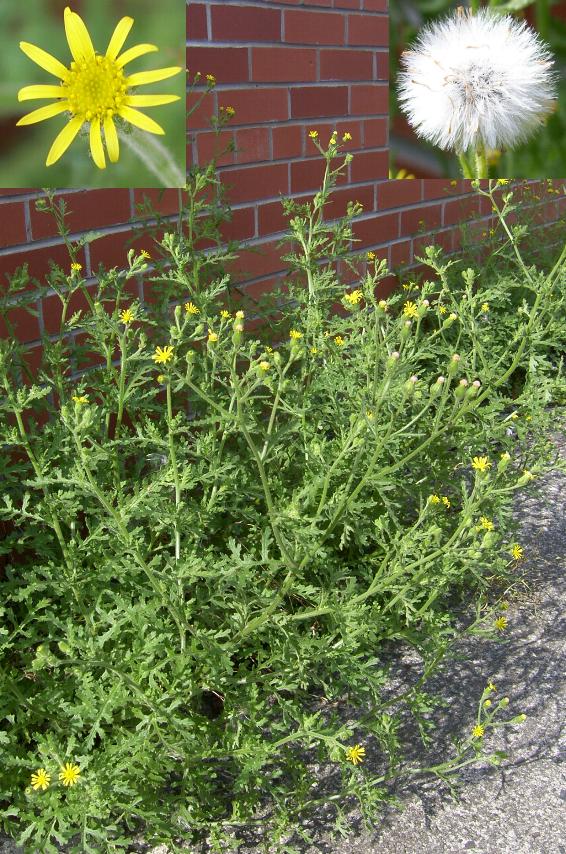Oxford RagwortScientific Name: Senecio squalidus |
Oxford Ragwort is not native to the British Isles, it a naturalised escape. It was brought from the slopes of Mount Etna in Sicily to the gardens of the Badminton estate at the end of the seventeenth century, then taken to the Oxford Botanic Gardens shortly afterwards. It escaped to the local area where it could be found growing on buildings giving rise to the common name. As the railways developed it preferred the conditions of the clinker beds and limestone ballast which were similar to the well-drained soils of its native habitat, using the expanding network to become naturalised throughout the British mainland. By the late twentieth century only northern Scotland was free of it and it had crossed to three major ports in Ireland where it is fanning out gradually from Belfast, Dublin and Cork. (The picture to the right was taken in an alley in South Belfast).
Oxford Ragwort is usually considered to be an annual, biennial or can be a short-lived perennial - it usually dies after producing seeds - ie. monocarpic. It prefers well-drained conditions found in waste ground, walls and railway banks, growing fom 0.3 to 1 metre high depending on the conditions with many branches and a stragling habit.
The hairless leaves are light to dark green, deeply lobed and turned down at the edges. The lower leaves may be less divided than the upper ones which are arranged alternately on the stem that is slightly ridged. They are more openly divided than Common Ragwort.
The yellow, daisy-like flowers are borne in loose clusters. The petals have rounded ends and to the back of the flower are black tipped bracts which continue for a short distance down the stem. After pollination by insects the seeds develop with a white pappus directly attached and collectively they form a spherical seedhead (insert upper right).
All parts of the plant contain Pyrrolizidine alkaloids that are toxic to cattle, deer, pigs, horses and goats, causing liver damage, and death is slow often occurring months after ingestion. Sheep are less affected, but should not consume the weed as the liver damage can be cumulative. The foliage has a distinctive unpleasent odour when crushed so poisoning by grazing is rare as it is instinctively avoided. If the plants are carelessly cut or uprooted and left around to wilt, they become palatable and the alkaloids are still potent, so grazing animals can be poisoned. Poisoning is less likely for Oxford Ragwort as it does not tend to grow in areas where animals graze or forage is harvested.
The fibrous rootball is easily removed, but due to the poisonous nature of the sap it is advisable to wear gloves when handling this weed. Glyphosate or a selective herbicide such asMCPA or 2,4D should be effective. As the plants become palatable when dead, grazing animals should be kept out of treated areas until they have rotted away or been removed.
Oxford Ragwort is an injurious weed and is specified in the Weeds Act 1959 so landowners are required to remove it. On roadside verges and waste land, local authorities should be contacted, but they are usually the main culprits in allowing it go grow.
See also Common Ragwort and Groundsel which have similar leaves and flowers.
In North America the Annual Ragweed, Ambrosia artimisiifolia, is a completely different plant, and the pollen it produces is a major cause of hayfever. Its foliage is fern-like and the flowers are borne on spikes. (also known as common ragweed, low ragweed, ragweed, Roman wormwood, short ragweed, small ragweed).
Giant Ragweed, Ambrosia trifida is a perennial with palmate leaves bearing three to five deeply cut lobes. (also known as blood ragweed, great ragweed, horseweed, perennial ragweed (great), tall ragweed)
